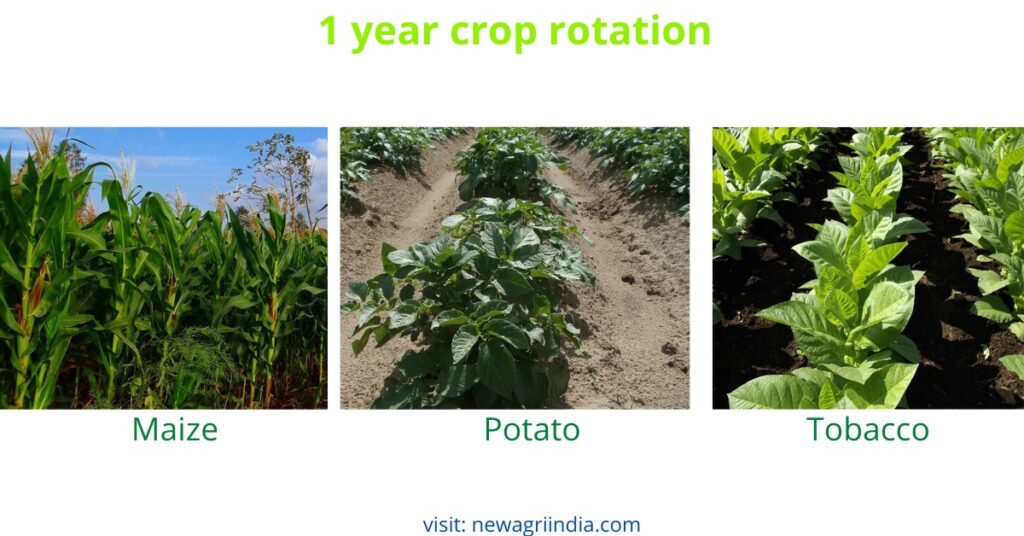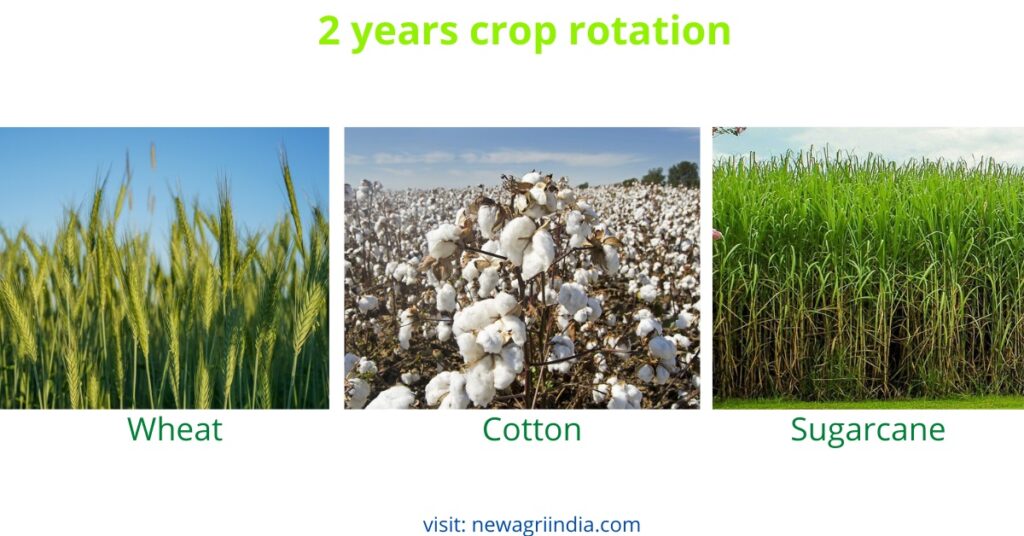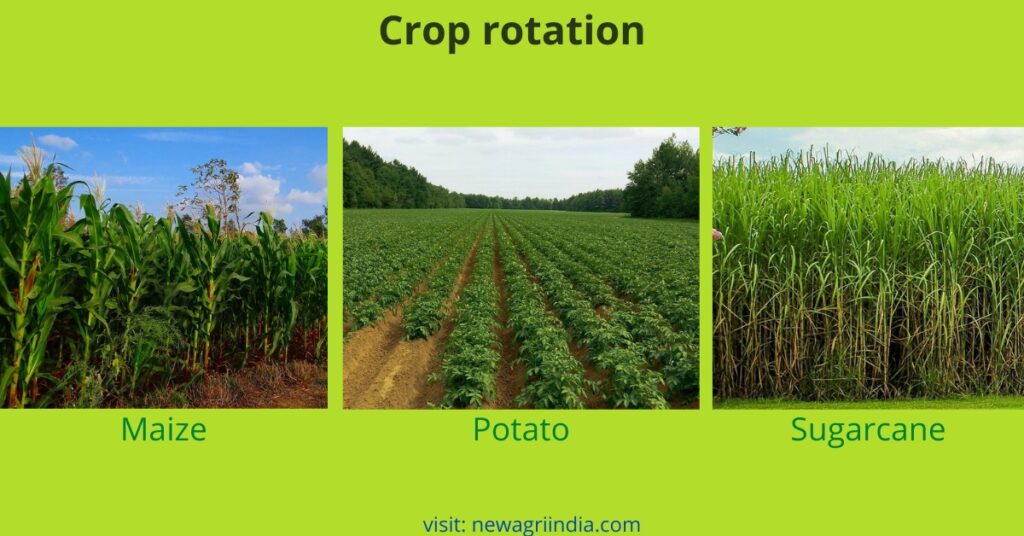What is crop rotation ?
1)The sowing of crops on any part or area of the soil, in a given time, in such a sequence that the fertility of the soil does not decrease, is called crop rotation.
2)Growing of crops on a piece of land for a fixed period of time in a pre planned succession, is called crop rotation.
3)On a certain land, repeated cultivation of crops or crop and follow land in a certain sequence is called crop rotation picture.
In simple words, in crop rotation land is fixed but crop is rotated year after year on the same land in such a sequence that the soil fertility keep remains.

Crop rotation examples
Rice- wheat-mung bean – 2020-21 (Ag. Year)
Rice-Mustard-Chilly -2021-22
Here, Wheat crop is rotated by mustard and moong by chilly in the next agricultural year.
Crop rotation intensity (%)
Crop rotation intensity = No. of crops in crop rotation/ No. of years in crop rotation*100
For Example: Rice-Pea (1 Year Crop Rotation)
∴ Crop Rotation Intensity = 2/1*100 = 200%
Groundnut-Wheat, Sugarcane (2 Years Crop Rotation)
∴ Crop Rotation Intensity = 3/2*100 = 150%
Paddy-Potato, Sugarcane, Pigeon pea-Wheat (3 years crop rotation)
∴ Crop Rotation Intensity = 5/3*100 = 166%
Principles of Crop Rotation
In order to get good yields of crops as well as to maintain the fertility of the soil, it is necessary for the farmers to have knowledge of the principles of crop rotation. The following principles should be kept in mind while preparing crop rotations for different crops-
- Deep root crops should be followed by less deep root crops so that the crops can take their nutrients and moisture from different soil surfaces.
- Pulses crops should be grown after non-pulses crops. Non-pulses crops weaken the soil by absorbing excess amounts of nitrogen from the soil, while the Rhizobium bacteria found in the roots of pulses crops increases the fertility of the soil by fixing the free nitrogen of the atmosphere in the soil.
- Crops that require more manure should be followed by crops that require less manure. So that the fertility of the soil is also protected.
- Crops that require more water should be followed by crops that require less water. Growing more water-intensive crops continuously prevents air circulation in the soil. This has a detrimental effect on the growth of roots and the actions of soil bacteria.
- While making the crop circle, the inclusion of crops in it should be such that the resources available with the farmer like labour, irrigation, fertilizers, seeds and money etc. can also be properly utilized. And the farmer should get all the necessary things like grains, vegetables, pulses, fodder for animals, fiber crops for clothes and cash money as per the requirement.
- Crop rotation should be made in such a way that such crops which are prone to the same type of harmful insects, moths and diseases should never be grown continuously.
- While preparing the crop rotation, the selection of crops should be done keeping in mind the soil and climate.
Advantages of Crop rotation
The the advantages of Crop rotation are as follow-
- It ensures balanced program of work throughout the year.
- It maintains and even improves the soil fertility.
- It checks the soil erosion and conserves moisture.
- The harmful pathogens, insect-pest, nematode and weeds which is associated with a particular crop can be managed.
- Different crops can be managed properly.
- It fulfilled the domestic needs of farmers.
- By adopting crop rotation, the resources available with the farmers are utilized properly.
- Crops are protected from the attack of pests, moths and diseases, due to which the cost is reduced and high yield is obtained.
- Suitable crop rotation is the key of modern agriculture which aims to produce maximum yield by maintaining soil productivity.
Types of crop rotation
Types of crop rotation are as follow:
1 year crop rotation
Maize – Potato – Tobacco (1 yr.)
Maize – Wheat or Barley (1 yr.)
Sorghum – Berseem (1 yr.)
Maize – Potato – Onion (1 yr.)
Sorghum – Wheat (1 yr.)
Sorghum – Wheat – Cowpea or Mung bean (1 yr.)
Paddy – Wheat – Cowpea or Mung bean (1 yr.)
Maize – Wheat + Gram (1 yr.)
Sorghum – Pea (1 yr.)
Paddy – Lathyrus (1 yr.)
Sorghum – Gram (1 yr.)
Finger millets or Kodo millets – Gram or Pea
2 years crop rotation

Maize – Potato, Sugarcane (2 yrs.)
Sorghum – Pea, Sugarcane (2 yrs.)
Cotton – Pea, Pearl millet – Gram (2 yrs.)
Sorghum – Gram, Maize – Wheat (2 yrs.)
Sorghum + Cluster bean- Gram, Pearl millets – lentil (2 yrs.)
Paddy – Pea, Paddy – Gram (2 yrs.)
Maize – Potato, Green manures – Wheat (2 yrs.)
Wheat – Cotton, Sugarcane (2 yrs.)
Paddy – Wheat, Maize – Potato (2 Yrs.)
3 years Crop Rotation
Cotton – Fenugreek, Sorghum – Wheat, Sugarcane (3 yrs.)
Groundnut – Pigeon pea, Sugarcane, Mung bean – Wheat (3 yrs.)
Paddy – Pea, sannhemp, Sugarcane (3 yrs.)
Sorghum – Pigeon pea, Fallow – Wheat, Sesame – Linseed (3 yrs.)
Sorghum – Pea, Sugarcane, Ratoon (3 yrs.)
4 years Crop rotation
Cotton – Fenugreek, Sugarcane, Ratoon, Sorghum – Wheat (4 yrs.)
How helpful was this post for you, tell me in the comment box and you can also give us your advice, your comment and advice are very important for us.
Thank you..!

Very nice and excellent Exclusive pictures of information. Thanks. .
.. . Thanks. Agri New 🆕 India.
Thank you Ashok Patil ji for your appreciation and encourage. I’ll always try my best to deliver useful information for the readers
Very relevant information.
thank you